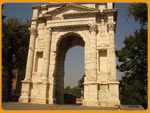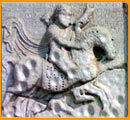|
|
||||||||||||||||||||||||||||||||||||||||||||||||||||||||||||
|
|
||||||||||||||||||||||||||||||||||||||||||||||||||||||||||||
|
|
Roman Verona
Verona, thanks to the abundance of Roman remains scattered all over its territory or exposed in its museums allows, like no other Italian city except Rome, to "travel" along the different steps of Roman history. With the support of Roman monuments and remains, the themes of the Roman history can by studied in specially designed didactic guided tours. The origins, the Empire, the decline and the first barbaric invasions, anlysing also the logistic aspects, the every day life, the religion, the politics, the economy of a typical roman city: Verona. Verona, with the Archaeological Museum, the Epigraphic Museum, and the Scavi Scaligeri (the exceptional underground museum of Verona) becomes a precious tool to understand and deepen the knowledge the complex history of the Roman age. The roads system
In the development of the Republican Age, Verona became a flourishing city, built according to typical Roman city planning outlines: the system of streets creating a regular grid (the reticulum), with the main square (forum) in its center, still clearly visible today in the disposition of roads in the historical center, and the gates, walls and buildings whose remains can be seen above and under ground all over town. WIth the help of a tourist guide you will be able to see all of these remains in a coherent didactic itinerary.
Verona as a Roman Colony in the imperial age, with its gorgeous buildings: the theatre, the decorated facades of the gates, the Gavi arch, the amphitheater, the public baths, the houses with their mosaics covered floors.
The daily life in the Roman age can be experienced once again in Verona with the collections of furnishings, small votive statues, objects of daily use, of the Archaeological Museum, in the incredible number of inscriptions displayed in the Lapidario Museum, through which the Romans recorded even the smallest events of daily life. The leisure time of the Romans can be imagined in the two thousands years old theatre and amphitheater.
The last phase of the Roman Empire, emerges in all its dramatic power in the alleys and the hidden public squares of Verona, where the remains of the Gallieno Walls are still visible. Constructed in only six months under the terror of one of the first barbaric invasions in the 265 A.D. they incorporate inscriptions, decorations and anything that the terrified Veronese population had closed at hand. To the final stage of the Roman Empire belong also the remains of the first early Christian basilicas and the first places of cult, visible in the complex of the Cathedral and hypogeum of Santa Maria in Stelle outside Verona. For any question or further information on didactic itinerararies or on guided visits in Verona, please write to:
|
|||||||||||||||||||||||||||||||||||||||||||||||||||||||||||











